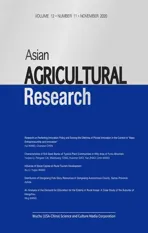Characteristics of Soil Seed Banks of Typical Plant Communities in Hilly Area of Funiu Mountain
2020-12-30YanjiaoLIPengsenCAIWeishuangTONGHuashanGAOYanZHAOLiminWANG
Yanjiao LI, Pengsen CAI, Weishuang TONG, Huashan GAO, Yan ZHAO, Limin WANG
1. Key Laboratory of Ecological Restoration in Hilly Area, Pingdingshan University, Pingdingshan 467000, China; 2. College of Horticulture and Plant Protection, Henan University of Science and Technology, Luoyang 471003, China
Abstract [Objectives] The purpose was to investigate the characteristics of soil seed bank of typical plant communities in hilly area of Funiu Mountain. [Methods] The seed density, number of species and species composition of the soil seed bank of typical plant communities such as Themeda japonica, Imperata cylindrica, Vitex negundo, Quercus acutissima, Robinia pseudoacacia, Platycladus orientalis and Populus canadensis in the surface, top 0-5 and top 5-10 cm soil were studied. [Results] The seed reserves of plant communities at different succession stages were (220.00±95.39) - (2 650.00±1 064.52) seeds/m2. A total of 48 species were counted in the seed bank, belonging to 45 genera in 22 families. Total 27 species were identified in the above-ground vegetation, belonging to 25 genera in 14 families. In the shallow soil where the seeds gathered, the seed densities of Imperata cylindrica and Themeda japonica were relatively low. The reserves of plant communities with different naturalness degrees were (403.33±64.29)-(2 110.00±356.79) seeds/m2. A total of 67 species were counted in the seed bank, belonging to 64 genera in 37 families. A total of 45 species were identified in the above-ground vegetation, belonging to 43 genera in 28 families. In the soil layers of 0-5 and 5-10 cm, the seed density of natural secondary Q. acutissima was higher than those of planted P. canadensis, P. orientalis and R. pseudoacacia. In each soil layer, the species number of natural secondary Q. acutissima forest was slightly smaller than those of planted P. canadensis, P. orientalis and R. pseudoacacia forests. [Conclusions] The seeds in the soil seed bank may not completely come from existing above-ground vegetation. Manual assistance is required for vegetation restoration or reconstruction relying on soil seed bank, to ensure the direction of community succession.
Key words Soil seed bank, Seed density, Species number, Species composition, Hilly area, Funiu Mountain
1 Introduction
Soil seed bank refers to the sum of all living seeds existing on the soil surface and in the soil[1]. It is a potential underground plant community and an important material basis for the natural regeneration of vegetation in the future. Therefore, studying the characteristics of soil seed bank is of great significance both in theory and practice[2]. It can predict community dynamics in theory[3], and in practice it is helpful to evaluating the provenance of vegetation restoration and reconstruction.
The main characteristic indices of soil seed bank research include seed density, number of species, and differences in the species composition between soil seed bank and the corresponding ground vegetation. Generally, the characteristics of soil seed bank are different for different vegetation types. The density of forest soil seed bank is generally 102-103seeds/m2, and that of grassland soil seed bank is generally 103-106seeds/m2[4-6]. The comparison of species composition between soil seed bank and the corresponding ground vegetation is usually measured by the similarity coefficient. Different community types lead to different conclusions. Liu Qingyanetal.[7]statistically analyzed the results of studies on the species similarity between wetland soil seed banks and the corresponding above-ground vegetation, and found that the soil seed bank of different wetland vegetation type has significant differences in species similarity with the corresponding above-ground vegetation. In the research on vegetation in the dry-hot valley and mountainous area of Jinsha River, Luo Huietal.[8]found that the species composition of the soil seed bank and the corresponding ground vegetation has a high similarity. In addition, succession stage of the above-ground plant community also has a greater impact on the characteristics of the soil seed bank. Zhao Liyaetal.[9]studied the characteristics of soil seed bank in the process of sandy land succession and restoration in the severely damaged land in Horqin Sandy Land. It was found that the species composition and density change of the soil seed bank were the same as those of the above-ground colonization community. Ou Zulanetal.[10]studied the soil seed bank of degraded vegetation in different succession stages in southwestern Guangxi and found that the similarity between any two succession stages was low, and the similarity coefficient of two adjacent succession stages was higher than that of two distant succession stages. The composition characteristics of seed banks of plant communities with different naturalness degrees are also different[11]. Chen Yongetal.[12]studied the characteristics of soil seed banks of plantation and natural forests ofBetulaalnoides. The results show that the number of seeds and species in the soil seed bank of plantation forest was smaller than that of natural forest; the plant species of the plantation and natural forests were different; and the plant species shared by the two accounted for the majority, and there was also a small part existing only in plantation forest or natural forest.
The hilly area of Funiu Mountain has serious soil erosion, shallow soil layer and poor fertility. The vegetation is low and sparse. Studying the soil seed bank of typical plant communities in the hilly area of Funiu Mountain is not only helpful to understand the dynamics and succession trends of the plant communities but also of important guiding significance for the near-natural restoration and later management of artificial plant communities in this type of areas.
2 Overview of study area and research method
2.1 Overview of study areaThe hilly area of Funiu Mountain (110°30′-113°30′ E and 32°45′-34°20′ N) is located in the southwest of Henan Province, China. The altitude is 44-2 173 m, mainly granite. The hilly area of Funiu Mountain is the transitional zone of the climate between the north and the south in China. It belongs to the subtropical-warm temperate and humid-semi-humid monsoon climate with obvious transition characteristics. Seasonal changes are obvious, and heat and water are at the same time. The total sunshine hours of the year are 1 800-2 200 h. The annual average temperature is 13.6-15.1 ℃. The annual precipitation is 700-1 100 mm. The soil is yellow brown earth. The vegetation is a transition type from warm-temperate deciduous broad-leaved forest to subtropical evergreen broad-leaved forest. The vertical band spectrum is obvious, with many types and wide distribution. Natural forests are mainly deciduous broad-leaved oak forests, and plantation forests mainly includeP.canadensisandP.orientalis[13].
2.2 Research method
2.2.1Soil sample collection of soil seed bank and germination experiment. The collection of soil samples from the soil seed bank was carried out in early March, 2017. During this period of time, the seeds of the previous year in the soil had not yet germinated, and there was no new seed input that year. Therefore, there were both short-term soil seed bank and long-term soil seed bank in the soil. It is a suitable time for sampling in the soil seed bank for full measurement. TheT.japonicaandR.pseudoacaciacommunities on the Guoding Mountain, theV.negundo,I.cylindrica,P.canadensisandP.orientaliscommunities in the Pingdingshan Peak Park and theQ.acutissimacommunity on Wugang Erlang Mountain were selected. Three sampling areas were arranged in each typical plant community type to collect soil samples from the soil seed bank. In each sampling area, 10 sampling points were arranged according to the "S"-shaped route. In each sampling point, a square of 10 cm × 10 cm was arranged. The surface of the soil was swept for sampling; and the soil in the layers of 0-5 and 5-10 cm was dug as samples.
The seed density, number species and species composition in the soil seed bank were determined with germination method. After removing large litter, the soil of each sample collected in the wild was divided into three equal parts and the seeds in the soil were let germinate in the germination tray. The germination experiment started at the end of March, 2017. The germination trays were placed in the greenhouse of Pingdingshan University and watered regularly every afternoon to keep the soil in the trays moist, so as to ensure the germination of the seeds. The germination situation of the seeds were observed and recorded regularly. The germination experiment lasted for one and a half years until no more species germinated.
2.2.2Investigation of characteristics of above-ground vegetation. The survey of characteristics of above-ground vegetation was carried out in summer. The species composition of the tree layer in each sampling area of the soil seed bank was investigated. Square of 5 m × 5 m were set for the survey on shrub layer. In each shrub survey square, a 1 m×1 m herb layer survey square was set along the diagonal. The composition and number of species was recorded.
2.2.3Statistical analysis. Density, species number, and species composition were selected to describe the characteristics of the soil seed bank. SPSS 16.0 was used for data processing and analysis. The differences in seed density and species number among different plant communities and different soil layers were analyzed by single-factor analysis of variance and multiple comparisons, with a confidence interval of 95%. The Sorensen similarity index was used to describe the species similarity between soil seed bank and the corresponding aboveground vegetation of each plant community, the species similarity between the soil seed banks, and the species similarity between the aboveground vegetation. Charts were drawn using Excel 2010.
3 Results and analysis
3.1 Characteristics of soil seed bank of plant communities at different succession stagesAs shown in Fig.1, on the soil surface, the seed density of the soil seed bank of plant communities at different succession stages was (220.00±95.39)-(2 650±1 064.52) seeds/m2. Among different plant species, the seed density ofV.negundowas the highest, (2 650.00±1 064.52) seeds/m2, significantly different from those ofI.cylindrica,T.japonicaandQ.acutissima(P<0.05). The seed density ofI.cylindricawas (1 340.00±525.07) seeds/m2. The seed density ofT.japonicawas the lowest, (220.00±95.39) seeds/m2. In the soil layer of 0-5 cm, the seed density of the soil seed bank was (323.33±182.30)-(2 000.00±975.96) seeds/m2. The seed density ofQ.acutissimawas the highest, (2 000.00±975.96) seeds/m2, significantly different from those ofI.cylindrica,T.japonicaandV.negundo(P<0.05). The seed density ofI.cylindricawas (936.67±416.21) seeds/m2. Among different plant species,T.japonicahad the lowest seed density, (323.33±182.30) seeds/m2. In the soil layer of 5-10 cm, the seed density of the soil seed bank was (270.00±51.96)-(916.67±284.31) seeds/m2. Among different plant species,Q.acutissimashowed the highest seed density[(916.67±284.31) seeds/m2], followed byI.cylindrica[(430.00±185.20) seeds/m2], andT.japonicashowed the lowest seed density[(270.00±51.96) seeds/m2]. There was no significant difference in seed density amongI.cylindrica,T.japonicaandV.negundo(P>0.05), and the seed density ofQ.acutissimawas significantly different from those ofI.cylindrica,T.japonicaandV.negundo(P<0.05).
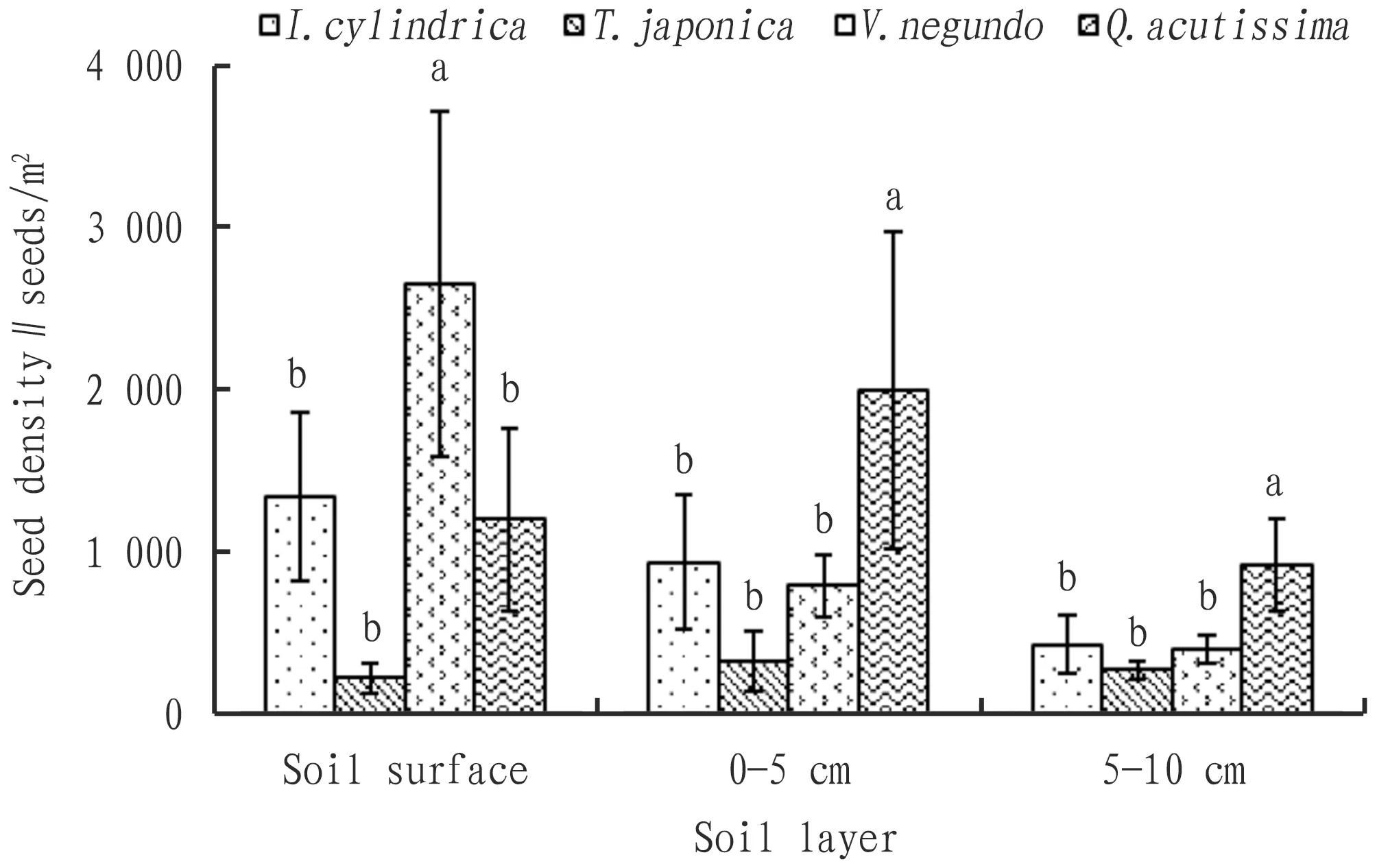
Fig.1 Seed density of soil seed banks of plant communities at different succession stages in different soil layers
On the soil surface, the species quantity in soil seed bank of plant communities at different succession stages was (4.33±2.08)-(15.33±3.06) species/0.01 m2.I.cylindricashowed the most species[(15.33±3.06) species/0.01 m2], followed byV.negundo[(12.33±0.58) species/0.01 m2], andT.japonicahad the least species[(4.33±2.08) species/0.01 m2]. There was no significant difference in species quantity betweenI.cylindricaandV.negundo,V.negundoandQ.acutissima, orQ.acutissimaandT.japonica(P>0.05), but the species quantity ofI.cylindricawas significantly different from those ofQ.acutissimaandT.japonica, and the species quantity ofT.japonicawas significantly different from that ofV.negundo(P>0.05). In the soil layer of 0-5 cm, the quantity of species in the soil seed bank ranged from (4.33±1.53) to (16.00±3.46) species/0.01 m2. Among different plant species, the species quantity ofI.cylindricacommunity was the highest, (16.00±3.46) species/0.01 m2, followed by that ofV.negundocommunity[(12.00±3.00) species/0.01 m2], and the species quantity ofT.japonicawas the lowest, (4.33±1.53) species/0.01 m2. The differences in species quantity betweenI.cylindricaandV.negundo, andT.japonicaandQ.acutissimawere insignificant (P>0.05), while those betweenI.cylindricaandQ.acutissima,T.japonica, and betweenV.negundoandT.japonica,Q.acutissimawere significant (P<0.05). In the soil layer of 5-10 cm, the species quantity of the soil seed bank was in the range of (3.67±2.08)-(11.00±1.00) species/0.01 m2.V.negundocommunity had the most species, (11.00±1.00) species/0.01 m2, followed byI.cylindrica, (9.00±3.46) species/0.01 m2, andT.japonicashowed the least species, (3.67±2.08) species/0.01 m2. There was no significant difference betweenI.cylindricaandV.negundo,I.cylindricaandQ.acutissima, orQ.acutissimaandT.japonica(P>0.05), and there were significant differences betweenI.cylindricaandT.japonica,T.japonicaandV.negundo, andV.negundoandQ.acutissima(P<0.05) (Fig.2).
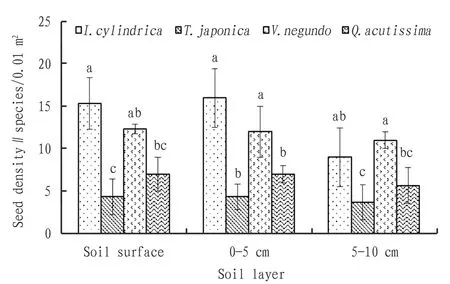
Fig.2 Species number of soil seed banks of plant communities at different succession stages in different soil layers
The Soresen similarity coefficients (SC) between soil seed banks of plant communities and the corresponding above-ground vegetation were calculated, and the results are shown in Table 1. The similarity coefficient between the soil seed bank ofI.cylindricacommunity and the corresponding above-ground vegetation was 0.60, relatively high, while the similarity coefficients between soil seed banks of the other three plant communities and the corresponding above-ground vegetation were low. Between the soil seed bank ofI.cylindricacommunity and the corresponding above-ground vegetation, the shared plant species wereArtemisiaargyi,I.cylindrica,Setariaviridis,Cynodondactylon,Broussonetiapapyrifera,T.japonica,V.negundo,Sonchusoleraceus,Digitariasanguinalis,Arthraxonlanceolatus,Cyperusiria,Conyzacanadensis,Artemisiacapillaris,ViolaphilippicaandOxaliscorniculata, a total of 15 species, belonging to 15 genera in 7 families. Among them, most were gramineous plants (6 species).
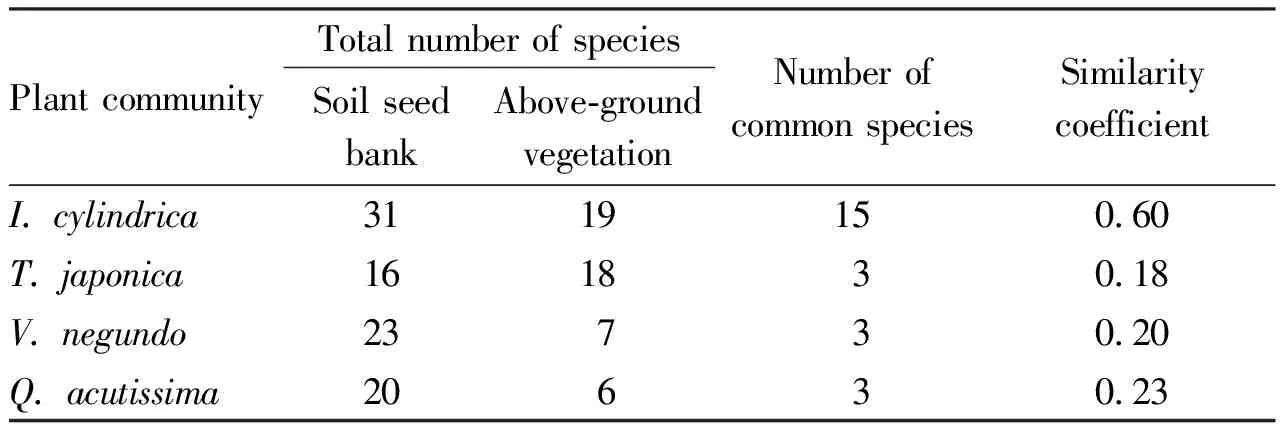
Table 1 Similarity of species composition between soil seed bank of different plant community and corresponding above-ground vegetation
The similarity between soil seed banks of different succession stages was analyzed, and the results are shown in Table 2. The soil seed banks ofI.cylindricaandT.japonicacommunities shared the following species:I.cylindrica,P.canadensis,S.viridis,C.dactylon,T.japonica,V.negundo,S.oleraceus,D.sanguinalis,A.lanceolatus,C.iria,Acalyphaaustralis,A.capillarisandO.corniculata, belonging to 13 genera in 7 families. The species similarity of the two soil seed banks was 0.55. The common plants between the soil seed banks ofI.cylindricaandV.negundocommunities wereA.argyi,S.viridis,C.dactylon,Lysimachiachristinae,V.negundo,S.oleraceus,Portulacaoleracea,D.sanguinalis,A.lanceolatus,Eleusineindica,C.iria,A.australis,ConyzaCanadensis,V.philippica,Medicagosativa,O.corniculataandChrysanthemumindicum, belonging to 17 genera in 10 families. The similarity coefficient between the soil seed banks was 0.63. The soil seed banks of theI.cylindricaandQ.acutissimacommunities shared the following species:I.cylindrica,V.negundo,A.lanceolatus,Duchesneaindica,C.iria,A.australis,C.canadensis,V.philippica,M.sativaandBroussonetiapapyrifera, belonging to 10 genera in 9 families. The similarity coefficient between the soil seed banks was 0.39. The common species between the soil seed banks ofT.japonicaandV.negundocommunitieswere S.viridis,C.dactylon,V.negundo,S.oleraceus,D.sanguinalis,A.lanceolatus,C.iria,A.australisandO.corniculata, belonging to 9 genera in 6 families. The similarity coefficient between the soil seed banks was 0.46. The soil seed banks of theT.japonicaandQ.acutissimacommunities showed the common species ofI.cylindrica,V.negundo,A.lanceolatus,C.iria,AlliumpaepalanthoidesandA.australis, belonging to 6 genera in 5 families. The similarity coefficient between the soil seed banks was 0.33. The soil seed banks of theV.negundoandQ.acutissimacommunities shared the species ofV.negundo,A.lanceolatus,C.iria,A.australis,C.canadensis,V.philippicaandM.sativa, belonging to 7 genera in 7 families. The similarity coefficient between the species of the two soil seed banks was 0.33.

Table 2 Similarity of species composition between soil seed banks of plant communities at different succession stages
The similarity in above-ground vegetation between different succession stages was analyzed, and the results are shown in Table 3. The common species in above-ground vegetation between theI.cylindricaandT.japonicacommunities includedA.argyi,T.japonica,D.sanguinalis,C.canadensisandA.capillaris, belonging to 5 genera in 4 families. The species similarity between the above-ground vegetation of the two communities was 0.27. The above-ground vegetation ofI.cylindricaandV.negundocommunities shared the species ofV.negundoandD.sanguinalis, belonging to 2 genera in 2 families. The species similarity between the above-ground vegetation was 0.15. The above-ground vegetation ofI.cylindricaandQ.acutissimacommunities had only one common species,B.papyrifera. The species similarity between the above-ground vegetation was 0.08. The above-ground vegetation ofT.japonicaandV.negundocommunities shared the following species:Ixerissonchifolia,L.bicolor,D.sanguinalisandStipabungeana, belonging to 4 genera in 3 families. The species similarity between the above-ground vegetation of the two communities was 0.32. There was no common species between the above-ground vegetation ofT.japonicaandQ.acutissimacommunities, andV.negundoandQ.acutissimacommunities, so the species similarity was both zero.

Table 3 Similarity of species composition between above-ground vegetation of plant communities at different succession stages
3.2 Characteristics of soil seed bank of plant communities with different naturalness degreesOn the soil surface, the seed density of soil seed bank ofR.pseudoacaciacommunity was the highest, (2 110±356.79) seeds/m2, followed by that ofP.canadensiscommunity[(1 883.33±635.09) seeds/m2], and the seed density of soil seed bank ofQ.acutissimacommunity was the lowest. In the soil layer of 0-5 cm, the seed density ranged from (970.00±554.35) to (2 000±975.96) seeds/m2. Among different species,Q.acutissimacommunity had the highest seed density, followed byR.pseudoacaciacommunity[(1 406.67±191.40) seeds/m2], andP.orientaliscommunity showed the lowest seed density, (970.00±554.35) seeds/m2. In the soil layer of 5-10 cm, the seed density ofQ.acutissimacommunity was the highest, followed by that ofP.canadensiscommunity, and the seed density ofP.orientaliscommunity was the lowest. There was a significant difference betweenP.orientalisandQ.acutissima(P<0.05) (Fig.3).

Fig.3 Seed density of soil seed banks of plant communities with different naturalness degrees in different soil layers
On the soil surface, the species number of soil seed banks of plant communities at different naturalness degrees was in the range of (7.00±2.00) - (17.33±5.69) species/0.01 m2.P.canadensiscommunity had the most species, followed byR.pseudoacaciacommunity andQ.acutissimacommunity had the least species. The differences amongP.canadensis,R.pseudoacaciaandQ.acutissimawere significant (P<0.05). In the soil layer of 0-5 cm, the species number of soil seed banks was (7.00±1.00)-(15.33±4.51) species/0.01 m2.P.canadensiscommunity had the most species, (15.33±4.51) species/0.01 m2. The species number ofR.pseudoacaciacommunity ranked second, (14.67±5.03) species/0.01 m2. The species number ofQ.acutissimacommunity was the least. There was no significant difference among the four plant communities (P>0.05). In the soil layer of 5-10 cm, the species number of the soil seed banks ranged from (5.67±2.08) to (10.67±3.51) species/0.01 m2.P.canadensiscommunity had the most species, (10.67±3.51) species/0.01 m2, followed byR.pseudoacaciacommunity[(10.00±2.00) species/0.01 m2], andQ.acutissimacommunities contained the least species. There was no significant difference among the four plant communities (P>0.05) (Fig.4).
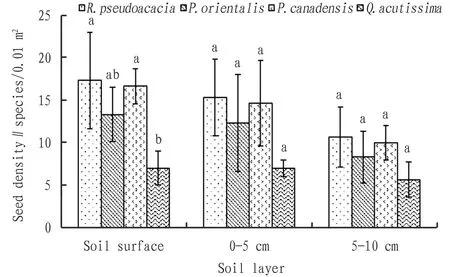
Fig.4 Species number of soil seed banks of plant communities with different naturalness degrees in different soil layers
The Sorensen similarity coefficient (SC) between the soil seed bank of different plant community and the corresponding above-ground vegetation was calculated. As shown in Table 4, the similarity coefficient between the soil seed bank ofP.canadensiscommunity and the above-ground vegetation was 0.81, and the similarity coefficients between the soil seed banks ofP.orientalis,R.pseudoacaciaandQ.acutissimacommunities and the corresponding above-ground vegetation were in the range of 0.14-0.23. The above-ground vegetation and soil seed bank ofP.canadensiscommunity shared the species ofA.argyi,Arabispendula,Rehmanniaglutinosa,Myosotonaquaticum,S.viridis,B.papyrifera,Eragrostispilosa,S.oleraceus,Aquilegiaviridiflora,P.oleracea,E.indica,C.iria,A.australis,Clinopodiumpolycephalum,Chenopodiumgracilispicum,C.canadensis,A.capillaris,Ixeridiumchinense,V.philippica,M.sativaandO.corniculata, belonging to 20 genera in 15 families, of which the composite plants are the majority.
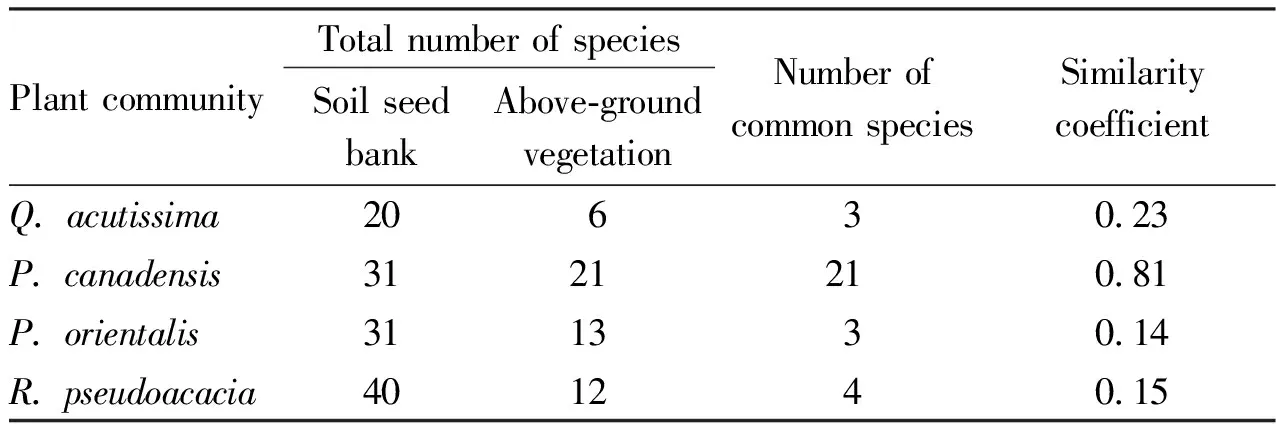
Table 4 Similarity of species composition between soil seed bank of different plant community and the corresponding above-ground vegetation
The similarity between soil seed banks of plant communities with different naturalness degrees was analyzed, and the results are shown in Table 5. The common species between the soil seed banks ofQ.acutissimaandPopuluscanadensiscommunities wereA.pendula,M.aquaticum,B.papyrifera,A.lanceolatus,Capsellabursa-pastoris,C.iria,A.australis,C.Canadensis,V.philippicaandM.sativa, belonging to 10 genera in 9 families. The similarity coefficient between the soil seed banks was 0.39. The soil seed banks of theQ.acutissimaandP.orientaliscommunities shared the species ofI.cylindrical,A.pendula,B.papyrifera,V.negundo,Sonchusarvensis,A.lanceolatus,C.iria,A.paepalanthoides,C.canadensis,V.philippicaandM.sativa, belonging to 11 genera in 9 families. The species similarity between the soil seed banks was 0.43. The common species between the soil seed banks ofQ.acutissimaandR.pseudoacaciacommunities includedB.papyrifera,V.negundo,S.arvensis,Ophiopogonjaponicas,A.lanceolatus,D.indica,C.iria,A.australis,C.CanadensisandV.philippica, belonging to 10 genera in 9 families. The species similarity between the soil seed banks was 0.33. The soil seed banks ofP.canadensisandP.orientaliscommunities shared the following species:A.argyi,A.pendula,S.viridis,B.papyrifera,L.christinae,S.oleraceus,P.oleracea,A.lanceolatus,Salixwarburgii,C.iria,C.gracilispicum,C.canadensis,A.capillaris,V.philippica,M.sativaandO.corniculata, belonging to 16 genera in 12 families. The species similarity between the soil seed banks of the two communities was 0.51. The soil seed banks ofP.canadensisandR.pseudoacaciacommunities had the common species ofA.argyi,R.glutinosa,S.viridis,B.papyrifera,S.oleraceus,Galiumaparine,P.oleracea,A.lanceolatus,Taraxacummongolicum,C.iria,A.australis,C.gracilispicum,C.canadensis,Leonurusjaponicas,A.capillaris,V.philippicaandO.corniculata, belonging to 17 genera in 12 families. The species similarity between the soil seed banks was 0.47.A.argyi,Astragalusscaberrimus,S.viridis,C.dactylon,B.papyrifera,V.negundo,S.arvensis,S.oleraceus,P.oleracea,D.sanguinalis,A.lanceolatus,Persicariahydropiper,C.iria,C.gracilispicum,C.canadensis,A.capillaris,O.corniculataandV.philippicawere common in the soil seed banks ofP.orientalisandR.pseudoacaciacommunities. They belong to 17 genera in 9 families. The species similarity between the soil seed banks was 0.51.

Table 5 Similarity of species composition between soil seed banks of plant communities with different naturalness degrees
The similarity between above-ground vegetation of plant communities at different naturalness degrees was analyzed, and the results are shown in Table 6.B.papyriferawas the only species shared by the above-ground vegetation ofQ.acutissimaandP.canadensiscommunities. The species similarity between the above-ground vegetation was 0.07.B.papyriferawas also the only species shared by the above-ground vegetation ofQ.acutissimaandP.orientaliscommunities. The species similarity between the above-ground vegetation of the two communities was 0.11. The common species between the above-ground vegetation ofQ.acutissimaandR.pseudoacaciacommunities wereB.papyrifera,MeliaazedarachandMorusalba, belonging to 3 genera in 2 families. The species similarity between the above-ground vegetation was 0.33. There was only one common species (B.papyrifera) between the above-ground vegetation ofP.canadensisandP.orientaliscommunities, and the similarity coefficient of the species composition was 0.06.B.papyriferawas also the only species shared by the above-ground vegetation ofP.canadensisandR.pseudoacaciacommunities, and the similarity coefficient of the species composition was 0.06. The above-ground vegetation ofP.orientalisandR.pseudoacaciacommunities showed the common species ofR.pseudoacacia,B.papyriferaandV.negundo, belonging to 3 genera in 3 families. The similarity coefficient of the species composition was 0.24.

Table 6 Similarity of species composition between above-ground vegetation of plant communities with different naturalness degrees
4 Discussion and conclusions
AmongI.cylindrical,T.japonica,V.negundoandQ.acutissimacommunities,I.cylindricalandT.japonicacommunities are herb succession stage,V.negundocommunity is shrub succession stage, andQ.acutissimacommunity is tree succession stage. In the soil surface and 0-5 cm soil layer where seeds gather, the seed density ofI.cylindricalandT.japonicacommunities in which herbaceous plants are the dominant are relatively low. Between them, the see density of theT.japonicacommunity is lower. This might be because that the dense cluster and higher plant height ofT.japonicahinder the import of seeds into the community. Coupled with its own strong asexual reproduction ability and weak seed reproduction ability, the soil seed bank has a lower seed density and fewer species. The clumps ofI.cylindricalcommunity are generally dense, but the plants are not as upright asT.japonica. The lighter seeds are easier to spread in by wind. Consequently, the seed density is slightly higher than that ofT.japonica[14]. The seed density ofV.negundocommunity is high in the surface soil. As the soil layer deepens, the seed density gradually decreases. The possible reason is thatV.negundohas a large seed yield and seed volume, and it will be more difficult for seeds to enter the soil. Therefore, they basically have little chance to migrate downwards with the help of natural forces[15-16]. The seeds of theQ.acutissimacommunity are mainly distributed in the 0-5 cm soil layer. It may be because most of the seeds on the soil surface, especially the seeds ofQ.acutissima, will be eaten or transported by animals, so the seed density is low[17]. The species similarity index of soil seed bank between plant communities at different succession stages is generally higher than that of the above-ground vegetation. The species similarity index between the above-ground vegetation is below 0.35. In particular, the species similarity index between above-ground vegetation ofQ.acutissimaandT.japonica,V.negundocommunities is zero. However, the species similarity index between the soil seed banks is 0.33. It indicates that seeds in the existing soil seed bank may not come from the existing above-ground vegetation completely. Once the existing above-ground vegetation is destroyed, if the soil seed bank is used for vegetation restoration or reconstruction, the succession direction may have multiple possibilities, and manual assistance is needed to ensure succession towards the target community.
The seed density of soil seed bank of natural secondaryQ.acutissimaforest is slightly higher than those of plantedP.canadensis,P.orientalisandR.pseudoacaciaforests. At different soil layer, the species number of natural secondaryQ.acutissimaforest was slightly smaller than those of plantedP.canadensis,P.orientalisandR.pseudoacaciaforests. The seed source of the soil seed bank of plantedP.orientalisandR.pseudoacaciacommunities with lower naturalness degree may be more diversified, including both the input of existing vegetation on the ground and the spread of surrounding vegetation. Fast-growingP.canadensisis the dominant plant community. The seeds in the soil seed bank may mainly come from the input of above-ground vegetation. Therefore, the species similarity index between soil seed bank and above-ground vegetation can reach 0.81. The species similarity between the soil seed banks of plant communities with different naturalness degrees is generally greater than that between the corresponding above-ground vegetation, which also means that once the existing ground vegetation of these plant communities is destroyed, the seed sources require to be regulated by restoration and reconstruction, supplemented by artificial control[18].
杂志排行
Asian Agricultural Research的其它文章
- Comparison of Spatial Forms between Villages under Different Cultures in Jiangxi Province: Taking Meipi Village and Zhuqiao Village as Examples
- Exploration on Ecological Compensation Mechanism of Family Farm
- Distribution of Dongxiang Folk Story Resources in Dongxiang Autonomous County, Gansu Province
- Resident Relocation of Wulingyuan World Natural Heritage Site Based on Community Participation Theory
- Influence of Social Capital on Rural Tourism Development
- An Analysis of the Demand for Education for the Elderly in Rural Areas: A Case Study of the Suburbs of Hangzhou
